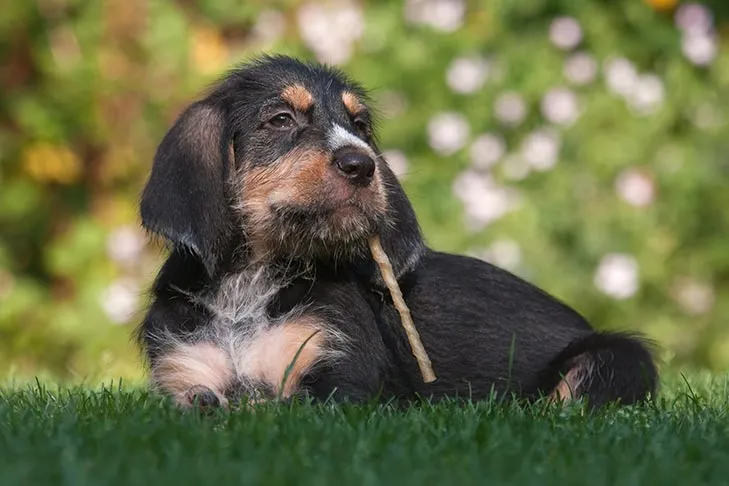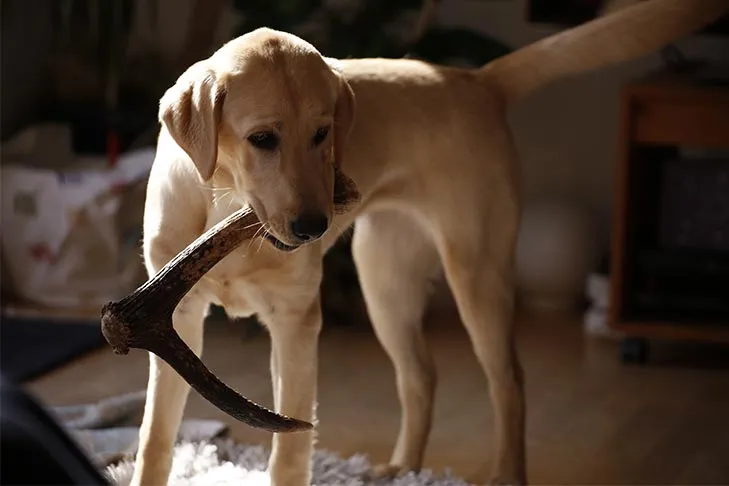Bringing a new puppy home is an exciting time, filled with boundless energy, playful nips, and an insatiable urge to chew. If you’ve ever found your puppy gnawing on furniture legs or your favorite pair of shoes, you know this instinct is powerful. For puppies, chewing isn’t just a habit; it’s a vital part of their development. It helps relieve the discomfort of teething, strengthens their jaw muscles, and is a key way they explore their new world. Providing appropriate chew bones also helps prevent destructive behavior, reduces anxiety, and keeps them mentally stimulated. However, with countless options on the market, understanding What Is The Best Chew Bone For A Puppy can be overwhelming. This comprehensive guide will help you navigate the choices, ensuring your furry friend stays happy, healthy, and safe.
Understanding Your Puppy’s Chewing Instincts
Puppies, much like human babies, go through a teething phase. This typically begins around 3 weeks of age and continues until all their adult teeth have emerged, usually by 6 months. During this period, their gums can be sore and itchy, and chewing provides much-needed relief. Beyond teething, chewing is an innate behavior for dogs of all ages. It helps clean their teeth, exercises their jaws, and offers a productive outlet for boredom or mild anxiety. For a puppy, every object is a potential toy to be explored with their mouth, making safe chew options even more critical.
Identifying Your Puppy’s Unique Chewing Style
Just like adult dogs, puppies have distinct chewing styles. What’s safe and satisfying for one puppy might be a choking hazard or too challenging for another. Observing your puppy’s chewing habits is crucial for selecting the appropriate chew.
- Gentle Chewers: These puppies tend to mouth and lightly gnaw on toys. They might prefer softer, more pliable textures and are less likely to destroy a chew quickly.
- Moderate Chewers: These puppies enjoy a good gnaw and can make their way through softer chews, but aren’t typically destructive to very tough toys. They need something durable enough to last but not so hard it poses a dental risk.
- Power Chewers: These puppies are determined. They can quickly shred and consume softer chews and may attempt to break off large pieces from harder options. They require highly durable, appropriately sized chews that can withstand intense gnawing without splintering or breaking into dangerous fragments.
Always supervise your puppy, especially when introducing a new chew. This allows you to assess their chewing style with that particular product and intervene if any piece breaks off or if they try to swallow chunks. If you notice your puppy exhibiting unusual chewing behaviors or seeming overly anxious, it might be worth consulting your veterinarian to rule out any underlying health issues. Ensuring your puppy’s overall well-being, including preventative care for lifelong joint health, often involves regular vet check-ups where such concerns can be addressed.
Essential Safety Factors When Choosing Puppy Chew Bones
Safety is paramount when selecting any chew for your puppy. Their developing teeth and digestive systems are more delicate than those of adult dogs. Here’s what to prioritize:
- Hardness: This is perhaps the most critical factor for puppies. A chew should be pliable enough that you can make a slight indentation with your thumbnail. If it’s too hard (e.g., you can’t indent it with your thumbnail), it poses a significant risk of fracturing your puppy’s delicate teeth, leading to pain and costly veterinary dental procedures.
- Durability: While not excessively hard, the chew must be strong enough to withstand vigorous chewing without breaking into large, swallowable chunks. If a chew is too soft, a power chewer might break off and ingest pieces that can cause choking or gastrointestinal obstruction.
- Size: The chew must be appropriately sized for your puppy. It should be large enough that your puppy cannot fit the entire item into their mouth at once, preventing choking. As your puppy grows, remember to adjust the size of their chews accordingly.
- Ingredients: Opt for chews with limited, natural ingredients. Avoid artificial colors, flavors, preservatives, and excessive salt or sugar, which can upset a puppy’s sensitive stomach or contribute to long-term health issues. Always check for known allergens if your puppy has sensitivities.
- Digestibility: For edible chews, digestibility is key. Puppy digestive systems are still maturing, so easily digestible ingredients are essential to prevent upset stomachs, vomiting, or diarrhea.
- Supervision: No chew is 100% risk-free. Always supervise your puppy while they are chewing. Remove the chew if it becomes small enough to be swallowed whole or if pieces break off.
Top Picks: What Are The Best Chew Bones For A Puppy?
Choosing the right chew can make a world of difference for your puppy’s comfort and your peace of mind. Here are some of the best and safest options tailored for young canines:
1. Puppy-Specific Rubber and Nylon Chews
While not edible, these are indispensable for teething puppies. Look for products specifically labeled “for puppies” as they are designed with softer, more flexible materials than adult versions.
- Benefits: Durable, non-toxic, many are textured to massage gums, and some can be frozen for extra soothing relief during teething. They provide an appropriate outlet without the risk of splintering or ingestion.
- Considerations: Ensure they are made from high-quality, non-toxic rubber or nylon. Replace them if they become damaged or pieces break off.
2. Bully Sticks (Puppy-Sized)
Made from a single ingredient (beef muscle), bully sticks are generally highly digestible and a favorite among dogs. For puppies, look for thinner, shorter options.
- Benefits: Long-lasting for moderate chewers, don’t splinter, and the texture helps clean teeth as they gnaw. They are a natural, protein-rich treat.
- Considerations: Even puppy-sized bully sticks can be consumed quickly by aggressive chewers. Always supervise and remove the stick when it becomes small enough to be a choking hazard. Bully stick holders can be helpful to prevent them from swallowing the nub.
 A happy Otterhound puppy playing on the grass with a safe chew toy, ideal for teething.
A happy Otterhound puppy playing on the grass with a safe chew toy, ideal for teething.
3. Yak Cheese Chews (Puppy-Friendly)
These hard blocks of dried yak (and sometimes cow) milk are low in lactose and generally well-digested. While very hard, smaller, softer variations designed for puppies are available.
- Benefits: Very long-lasting, natural ingredients, and low odor. They can be a great option for persistent chewers.
- Considerations: The hardness can still pose a risk for very young puppies or those with sensitive teeth. Always supervise. When the chew gets too small, remove it. Small pieces can be microwaved briefly until they puff up, then cooled and given as a crunchy treat to avoid choking hazards from tiny nubs.
4. Dried Tendons and Trachea
Derived from animal parts like beef trachea or backstrap, these natural chews are often softer than bones or antlers and can be a good source of protein and collagen. Beef trachea also contains natural chondroitin and glucosamine, which are beneficial for developing joints.
- Benefits: Softer texture makes them safer for puppy teeth. Good source of natural nutrients. Generally digestible.
- Considerations: Some puppies may consume these quickly. Ensure the size is appropriate to prevent swallowing large chunks. Always check for coatings or additives that might upset a puppy’s stomach. For overall dog health, managing certain health conditions often starts with proper nutrition and care in puppyhood.
5. Veterinary-Recommended Dental Chews
Many brands offer edible dental chews specifically formulated for puppies. These often have unique shapes and textures designed to clean teeth and promote healthy gums.
- Benefits: Scientifically formulated to be safe and effective for dental health. Often endorsed by veterinary dental organizations.
- Considerations: Always choose ones appropriate for your puppy’s size and age. Check ingredients for allergens. While beneficial, they should not replace regular dental care.
Chew Bones to Avoid or Use with Extreme Caution for Puppies
Some chews that are suitable for adult dogs can be highly dangerous for puppies.
- Rawhide: Often difficult to digest and can break off into large, indigestible chunks that pose a severe choking and intestinal obstruction risk. It is generally best to avoid rawhide for puppies.
- Antlers: These are extremely hard and can easily fracture a puppy’s developing teeth. Splinters can also pose serious internal injury risks. Many veterinarians advise against antlers for dogs, especially puppies.
- Cooked Bones: Cooked bones (from chicken, pork, beef, etc.) become brittle and can splinter easily, leading to choking or severe internal punctures and damage to the digestive tract. Never give cooked bones to a puppy.
- Very Hard Recreational Bones: While raw recreational bones (like beef marrow bones) can be appropriate for some adult dogs under strict supervision, they are generally too hard for puppy teeth. The risk of tooth fracture is high.
- Highly Processed Chews: Many mass-produced chews contain fillers, artificial ingredients, and preservatives that are unhealthy for puppies and can cause digestive upset.
 A Labrador retriever holding an antler, illustrating a common chew type, with considerations for puppy safety.
A Labrador retriever holding an antler, illustrating a common chew type, with considerations for puppy safety.
When considering chews, always err on the side of caution. Serious orthopedic issues, for example, might result from an accident, but even minor injuries from unsuitable chews can lead to discomfort. If you’re ever unsure about a specific product, consult your veterinarian for personalized advice.
Introducing Chew Bones to Your Puppy
Once you’ve selected a safe and appropriate chew, introduce it to your puppy gradually.
- Supervise Closely: Always stay with your puppy during chewing sessions, especially at first.
- Rotate Chews: Offer a variety of safe chews to keep your puppy interested and prevent them from getting bored with just one type.
- Positive Association: Make chewing a positive experience. Praise your puppy when they chew on their designated toys.
- Size Up: As your puppy grows, ensure their chews are still appropriately sized. A chew that was safe at 8 weeks might be a choking hazard at 6 months.
Conclusion
Choosing the best chew bone for a puppy involves careful consideration of their age, chewing style, and safety. By prioritizing appropriate hardness, durability, size, and natural ingredients, you can provide your puppy with healthy and satisfying outlets for their natural chewing instincts. Always supervise chewing sessions and consult your veterinarian if you have any doubts or concerns about a particular chew. A safe and engaging chew routine is an investment in your puppy’s dental health, mental well-being, and overall happiness, helping them grow into a well-adjusted and joyful companion. For a holistic approach to their development, remember that comprehensive parasite control is also a vital part of puppy care.
